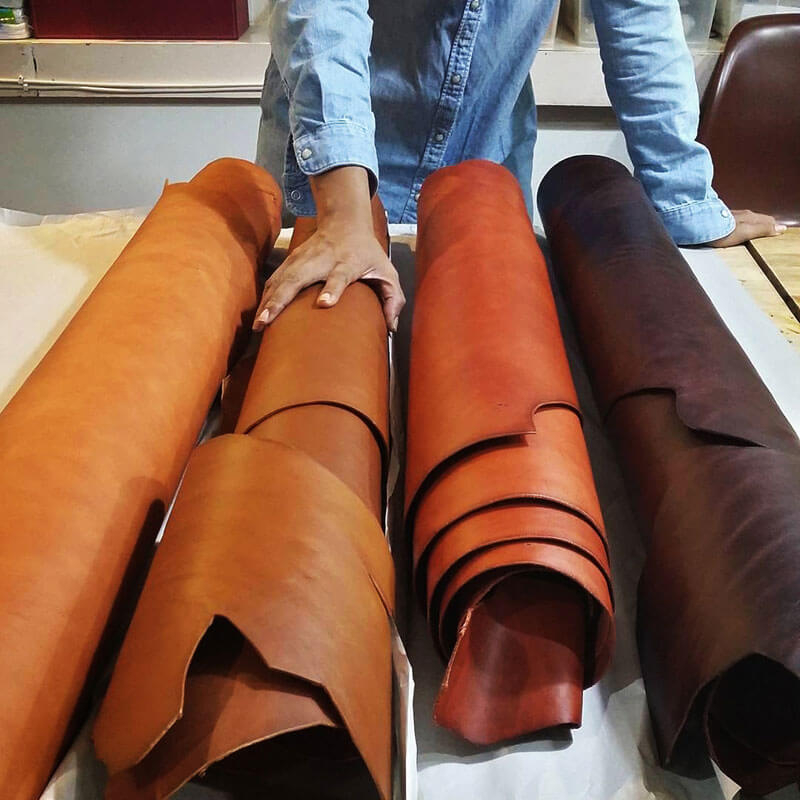
Leather design is the process of creating products made from leather, such as bags, shoes, belts, jackets, and wallets. It involves various stages, from selecting the raw materials to finishing and embellishing the final product.
The design process typically begins with sketching out ideas and creating prototypes using paper or fabric patterns. Once the design is finalised, leather is carefully selected and cut to the appropriate shapes and sizes. The leather pieces are then assembled using various techniques such as sewing, riveting, and glueing.
The finished product is often polished or treated to give it a desired texture or finish. Some leather designers also add embellishments like studs, buckles, and zippers to enhance the look of the final product.
Leather design is a specialised field that requires a combination of artistic and technical skills. It involves a deep understanding of the characteristics of different types of leather, as well as the ability to create functional and aesthetically pleasing designs.
Leather design is a field that offers a variety of courses that are popular among students who are interested in learning the art of designing and creating leather products. Here are some of the most popular courses in leather design:
Leathercraft: Leathercraft is a course that teaches students the basics of leatherworking. This course covers the tools and techniques used in leatherworking, as well as the different types of leather and their properties.
Leather bag making: This course teaches students how to design and make leather bags. Students learn how to create patterns, cut and stitch leather, and add hardware and finishing touches to their designs.
Shoe making: This course focuses on designing and creating leather shoes. Students learn how to create patterns, cut leather, and assemble shoes using traditional techniques.
Leather accessory making: This course teaches students how to create leather accessories such as belts, wallets, and phone cases. Students learn how to create patterns, cut and stitch leather, and add hardware and finishing touches to their designs.
Leather carving and tooling: This course teaches students how to carve and tool leather to create intricate designs and patterns. Students learn how to use tools such as stamps, punches, and knives to create their designs.
Leather dyeing and finishing: This course teaches students how to dye and finish leather to achieve different colours and textures. Students learn about different types of dyes and finishes, and how to apply them to leather.
Overall, these courses are popular because they offer students the opportunity to learn a unique and valuable skill set that can lead to a variety of career opportunities in the fashion and design industries.

Leather design courses can vary in popularity depending on factors such as location, industry demand, and personal interests. However, some of the most popular courses in leather design are:
Leather bag and accessory design: This course focuses on designing and creating leather bags and other accessories, such as belts and wallets.
Leatherworking and tooling: This course teaches the traditional techniques of leatherworking, including tooling, carving, stamping, and dyeing leather.
Shoe design and production: This course teaches students how to design and produce leather shoes, from pattern-making to finishing.
Leather upholstery: This course focuses on using leather in upholstery and furniture design, teaching students how to choose leather types, patterns, and colours.
Leather carving and embossing: This course teaches students how to create intricate designs on leather using carving and embossing techniques.
Leather restoration and repair: This course is focused on restoring and repairing old or damaged leather products, including bags, shoes, and furniture.
Leather garment design: This course focuses on designing leather garments, such as jackets and coats, and includes pattern-making, cutting, and stitching techniques.
Leather dyeing and finishing: This course teaches students how to dye and finish leather using various techniques, including airbrushing, hand painting, and spray painting.
These are just a few examples of popular courses in leather design, and there may be other courses that are more popular in specific regions or industries.
Leather design courses are gaining popularity due to the increasing demand for leather products in the fashion industry. Here are some popular courses in leather design:
Leather Accessories Design: This course focuses on designing and creating leather accessories such as bags, wallets, belts, and shoes.
Leather Garment Design: This course is all about designing leather jackets, coats, skirts, and pants.
Leather Crafting: This course teaches the techniques of leather crafting, such as carving, stamping, embossing, and dyeing.
Leather Technology: This course focuses on the scientific and technical aspects of leather production, including the processing of raw hides into finished leather products.
Leather Merchandising and Marketing: This course focuses on the marketing and sales aspects of leather products, including the analysis of market trends and consumer behaviour.
Leather Design Management: This course teaches the principles of design management in the leather industry, including product development, production, and marketing.
Leather Footwear Design: This course focuses on designing leather shoes and boots, including pattern-making, construction, and finishing techniques.
Leather design courses offer students the opportunity to learn new skills and techniques, and develop a strong foundation in the leather industry. Graduates of these courses can pursue careers in fashion design, product development, production management, and sales and marketing.